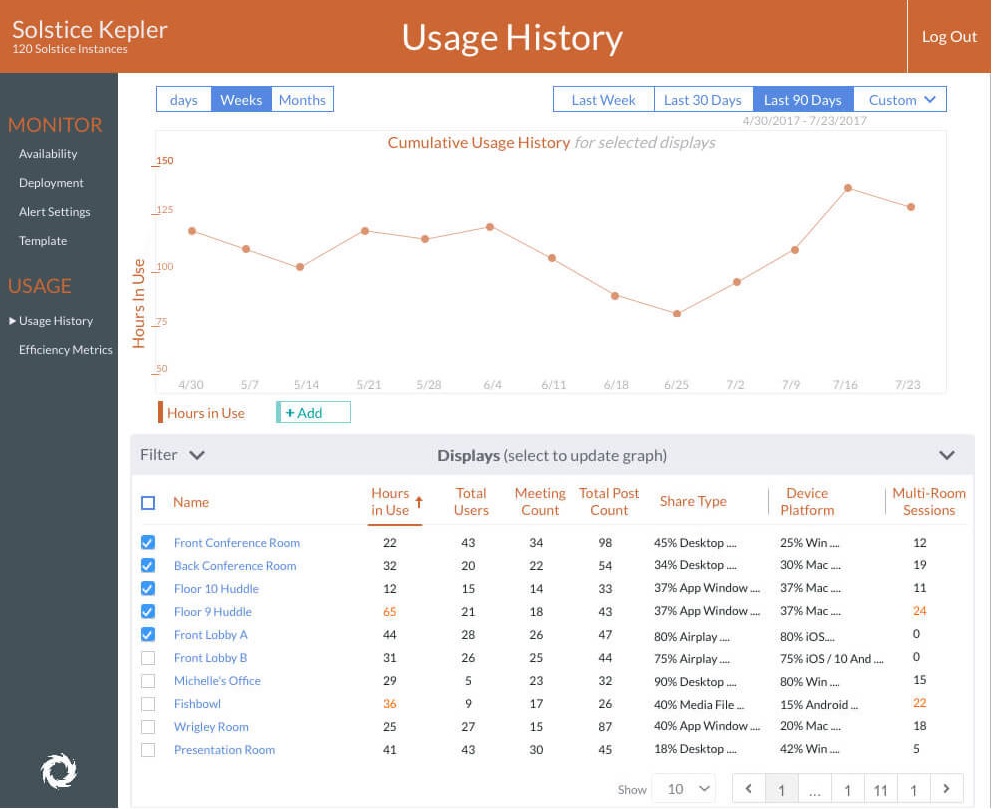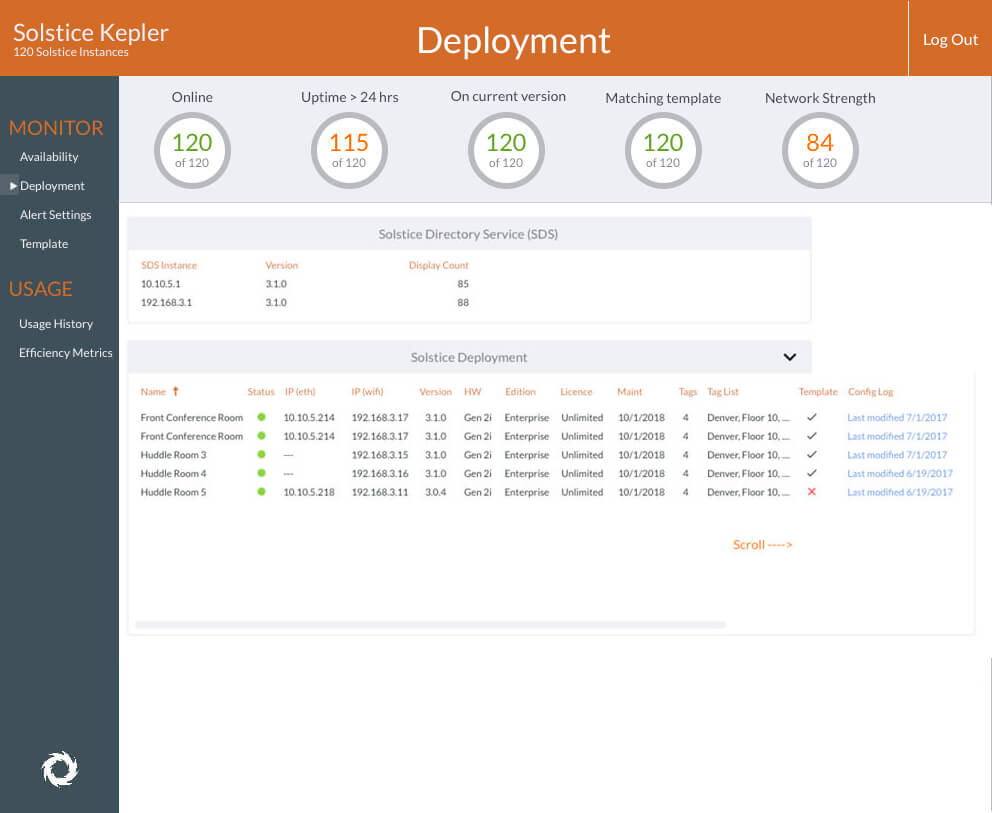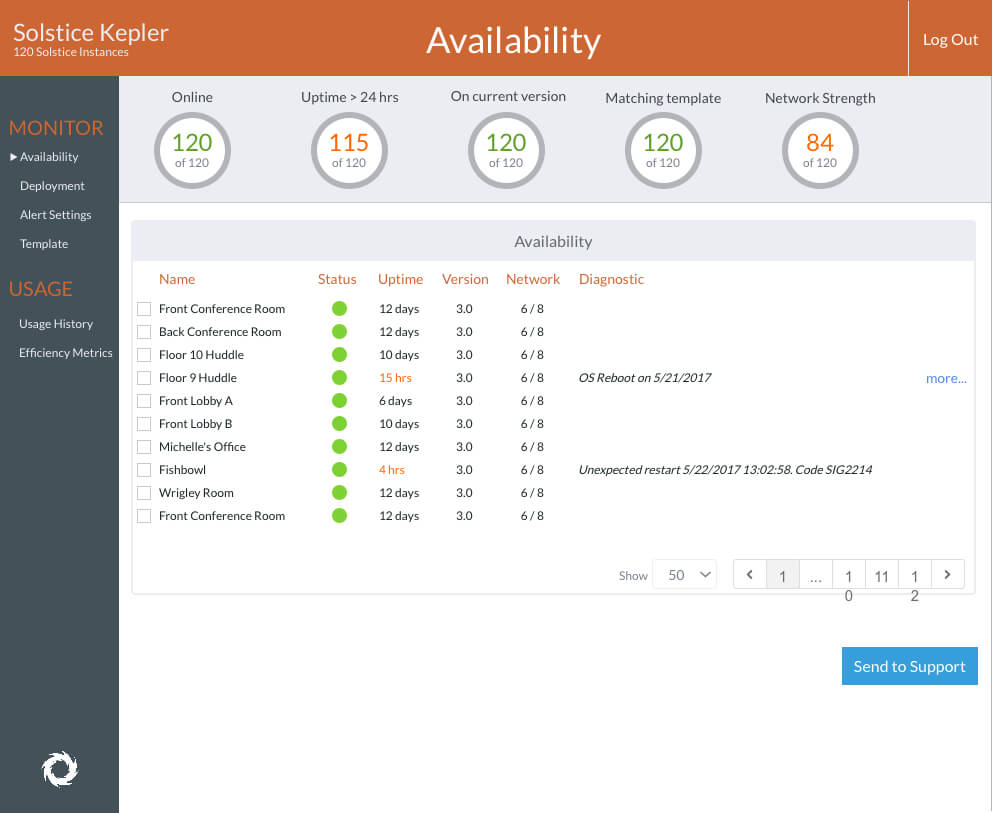[related]Mersive has a lot to discuss with the international integration community during ISE 2018. The collaboration solutions provider is debuting a cloud-based room monitoring and meeting analytics service called Solstice Kepler. And it’s adding a room scheduling feature to its popular Solstice line.
Meanwhile, the Denver-based company Mersive is poised to push forward its globalization efforts during the four-day trade show in Amsterdam.
CEO Rob Balgley took time before Integrated Systems Europe 2017 to discuss Mersive’s plans with CI:
At ISE 2018, Mersive will debut Solstice Kepler, cloud-based room monitoring and meeting analytic service. What should integrators and technology managers know?
Balgley: Solstice Kepler is based on a fundamental assumption that content is a gold standard for understanding what goes on in the meeting space. When you look at how Solstice Kepler is going to work, Kepler is going to collect data from the users in the meeting.
Think about scoring the meeting afterwards, kind of like you do for a ride service like Uber or Lyft. You’re going to be able to say, “Well, that was a 3-star meeting,” or, “That was a 5-star meeting.”
It doesn’t matter whether you’re on a Windows product, an Apple product or you’re on one network or another network — or depending on the display that you’re on.
We’re going to collect data from everything that’s going on in the meeting room, so we’re going to know what got connected in terms of the device.
We’re going to know what application got used.
We’re going to know how long.
All the data’s going to be anonymous, but what it’s going to do is it’s going to create pattern recognition. We’re going to be able to develop over time kind of a gold standard, a best practice, of what works best.
In other words, think about scoring the meeting afterwards, kind of like you do for a ride service like Uber or Lyft. You’re going to be able to say, “Well, that was a 3-star meeting,” or, “That was a 5-star meeting.”
Over time, you’re going to develop a best practice methodology for what works best, what size display works best.
What kind of network bandwidth do you need to do media streaming? What devices do most people share from? Are they sharing from iPads? Are they sharing from Surface Pros? Are they sharing from an Android phone? What are they sharing? How long are they sharing it? How many people are sharing content?
All that data is going to allow us to look more closely at ROI and productivity, which are the two things that drive deployment and get us to a best practice point in time.
Integrators should be in the business of not just providing companies with the AV technology to help them with their meetings but in the business of helping customers with meetings.
Balgley: This takes us from understanding purchase data to understanding behavioral data … You might be able to say, “Why is it that the rooms in this area of the building are so much more productive than the rooms in this area of the building?”
They might both have the same displays. They might both have the same network bandwidth, but what you noticed is the furniture’s configured differently. Maybe the furniture’s more configurable. Maybe you find out that your soft lounges are much more productive than your more structured, traditional meeting spaces.
All this information’s going to go a long way.
We’re interested in productivity and we’re interested in ROI. That’s what we want to give back to the resellers and to the end users, to say, “When you score meetings, these are the meetings that do best. Here’s why. Here’s what’s in those rooms.”
There should be a pretty strong cause and effect.
What about from an integrator’s perspective? Do you think integrators could benefit from this technology insomuch as being able to help them provide value and service contracts?
Balgley: Solstice Kepler was built as a result of the feedback that we got from both partners and end users. Solstice Kepler is really a way of extending your managed services that you offer today, because is it’s going to give you a real-time view.
It’s going to give you a live status of what’s happening in the room (room monitoring), so you can get alert notifications, you can get statuses, and you can figure out what’s going on. You can see problems. You can diagnose problems. You can go into the Solstice dashboard, then, and fix things.
Solstice Kepler is really a way of extending your managed services that you offer today, because is it’s going to give you a real-time view.
It’s absolutely intended to be resold by resellers to the end user customers to provide another layer of value and to help them be sticky in the sense that there’s affinity and loyalty developed between themselves and their customers.
The things that we’re going to provide through Solstice Kepler are not really available today in the context of a collaborative meeting, so the data that they’re going to get is going to allow them to, on a presales basis, go in and say, “Best practice looks like this.”
This is as much about facilities management. This is the kind of data that can go right to not just the CTO but a CFO and say, “If you want to spend your money wisely, here’s what you’ll do. Here’s best practice for the size of the display.”
You guys are also adding room scheduling to Solstice. Can you talk about that feature?
Balgley: We get a lot of comments from people that say:
We continue to look at our position in the meeting space and try to drive as much technology, as much value, through that little black box.
“We like Solstice. We like the UI. You’re in the room with a couple of other really big vendors, so you’ve kind of earned a beachhead in our meeting spaces, both traditional and ad hoc …
What else can you do? What other things can you do with the pod? … Because, now that you’re in there and people are used to the UI and they like it, what are the other things that you can provide?”
That’s where things like digital signage [support via Solstice] came from, right? That was the predecessor to this strategy of continuing to disrupt hardware markets with software. We’re continuing to add digital signage.
We started about a year ago with the ticker that runs across the top and the ability to customize the welcome screen. Those are both directed at bringing digital signage into the meeting space.
Calendar is the same thing. You’ve also got some additional real estate, so calendar was step two. We’ve got other things coming in follow-up releases, where you’ll actually be able to use the welcome screen as a live web feed. We continue to look at our position in the meeting space and try to drive as much technology, as much value, through that little black box and that welcome screen in calendar. It really was the next logical step for us.
It’s your second ISE, and now you’ve got a bigger presence this year than you had last year. Can you talk a little bit about what Mersive’s global strategy is and where that’s going?
Balgley: One of the trends in AV right now is to create a standard global template for meeting room monitoring spaces. Everybody wants to have a global template. In other words, if you’re in a meeting space in New York, you want that meeting space to look like the meeting spaces in London.
There is very much a global initiate to achieve some kind of a global standard across these very, very large companies.
For us, ISE was a big hit last year. We did very well at the show. It was our first year. This year I think we have doubled the space.
One of our two or three biggest initiatives for 2018, is to build out our international business in Europe.
We have a much better space. We also hired Jeff Meyers, our general manager, last year, and Jeff now has the charge to build out our European sales organization.
[Meanwhile] we have a lot of business in the U.S. that’s being driven by a part of Mersive that’s actually not here.
We have financial services companies and pharmaceutical companies that are actually based in Europe that are driving business back here, because today it’s not unusual for a technology initiative to start in Europe and have it be ported back here to the U.S.
It never used to be that way, but today some pretty significant percentage of our business with large companies is being driven from somewhere else other than the U.S.
It’s an imperative for us to establish our presence there. Even without having boots on the ground for part of last year, we did very, very well. Barco has kind of had their way in that market.
There is no natural predator for Barco in Europe. We want to be able to give them a run for their money. They’re a bigger company. They have a bigger sales organization. They have tenure and maturity, but we’ve done very well competing in the United States against them.
We’re going to be building a significantly sized organization in Europe in 2018 under Jeff, under his leadership, and we think it’s going to be a lot of fun. ISE is that kickoff party.
We’re also going to be launching our language localization initiative; we’re going to be introducing new languages in German, French, Italian, Spanish and Chinese to start.
We already had Japanese, and we’ll be following on with additional languages, but in Version 3.2 of the product, which is out [just prior to] ISE, we’re going to be supporting Jeff and his team with local language support.
One of our two or three biggest initiatives for 2018 is to build out our international business in Europe.












